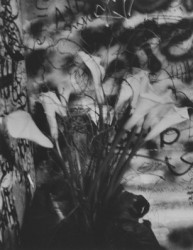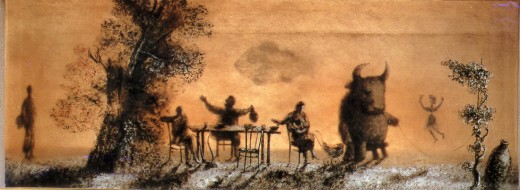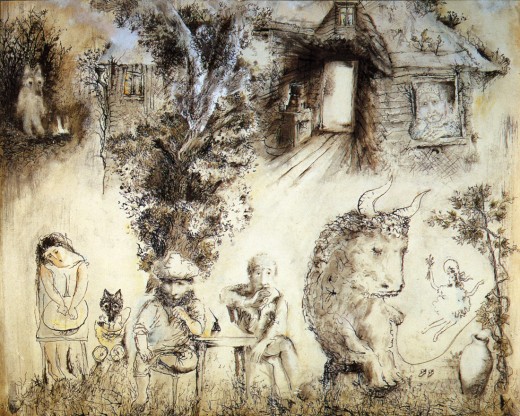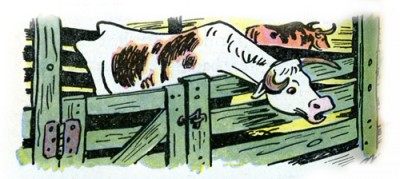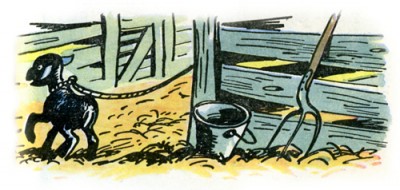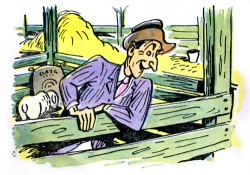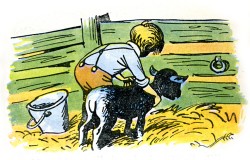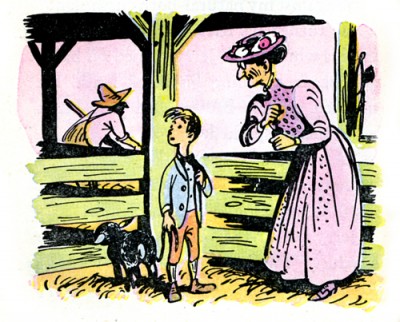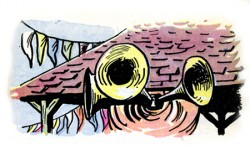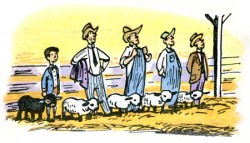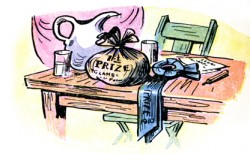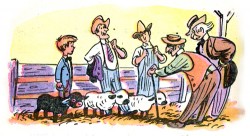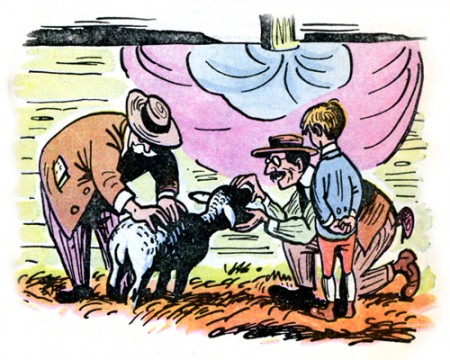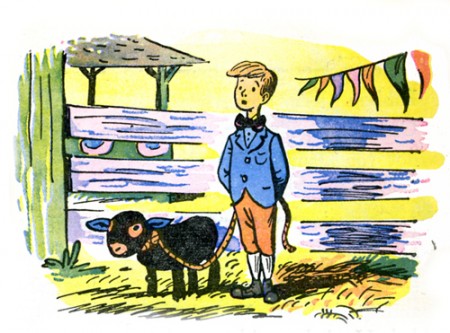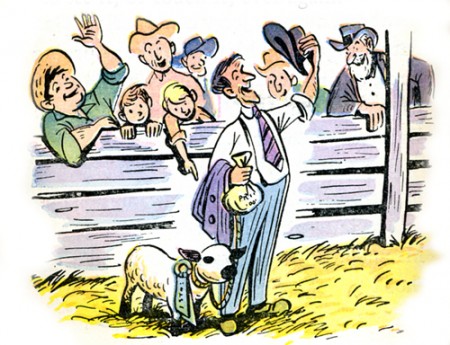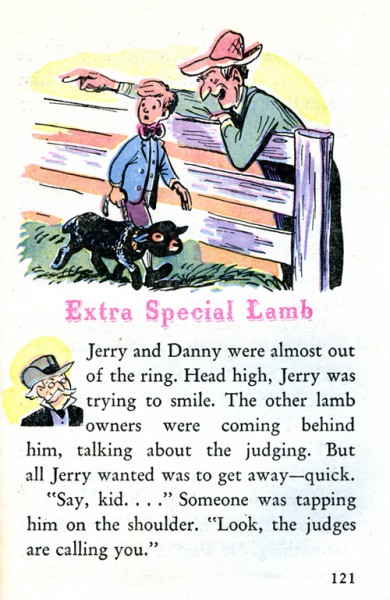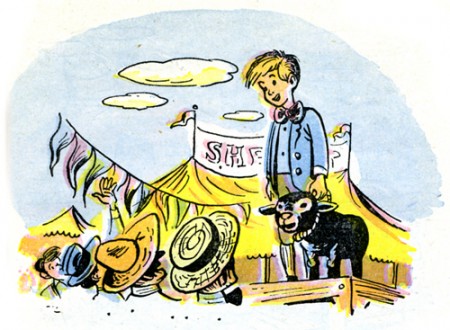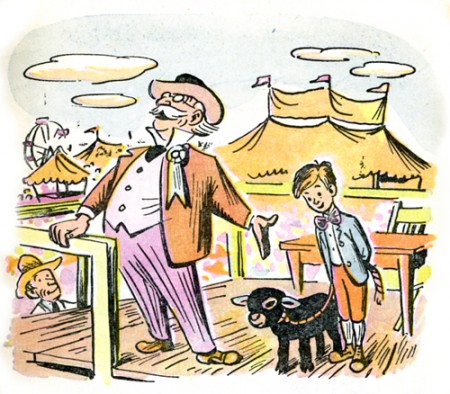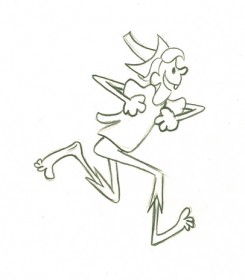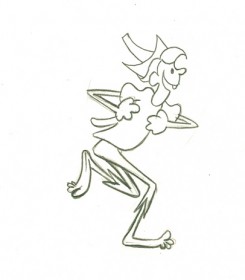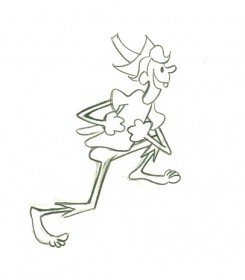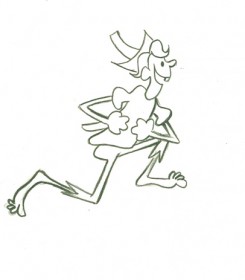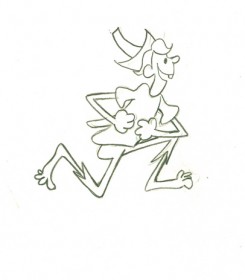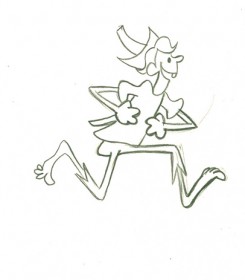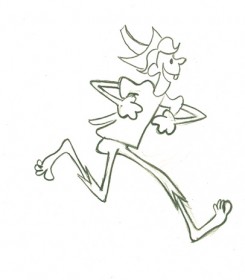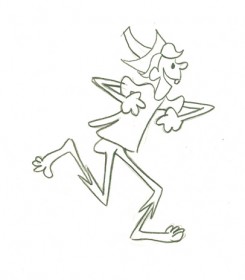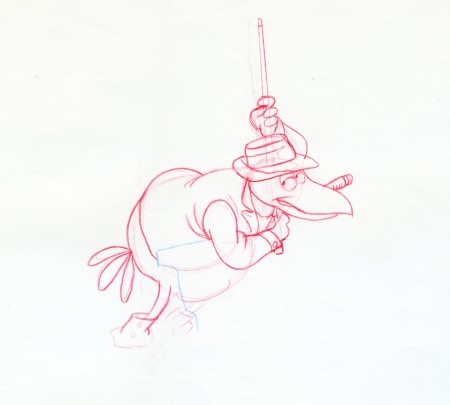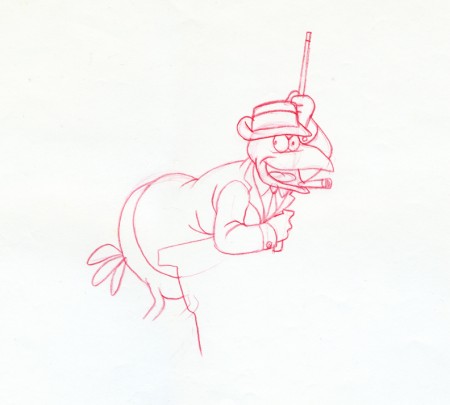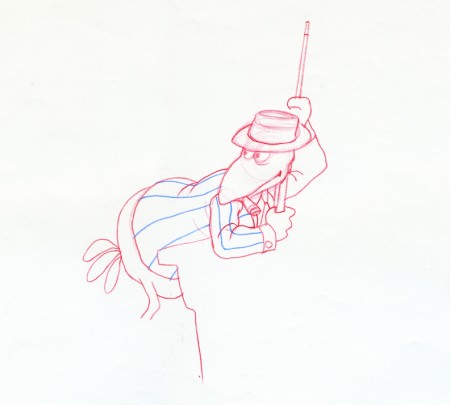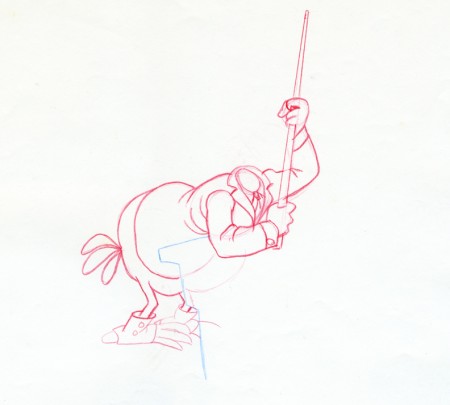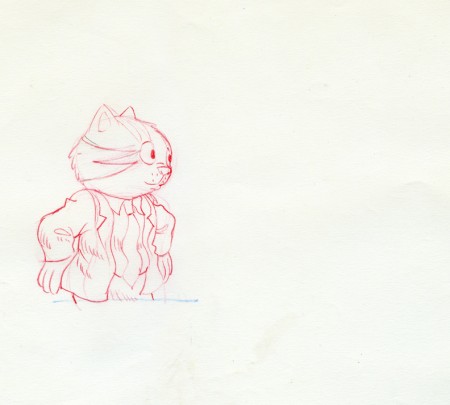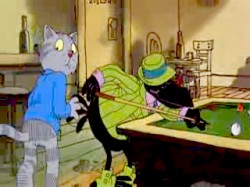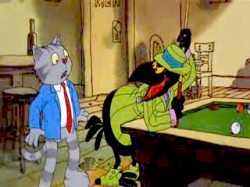Monthly ArchiveMarch 2009
Daily post 21 Mar 2009 08:15 am
Magoo’s Book

- Darrell Van Citters has written a thoroughly researched book which tells the story behind the 1961 UPA film, Magoo’s Christmas Carol. He spent considerable time contacting all surviving cast and crewmembers of the production and also interviewed surviving family members of those who are deceased. He worked closely with the estates of the producer, director, writer and songwriters in assembling the material for this book. Information and photos were also gathered from several archives.
Darrell writes:
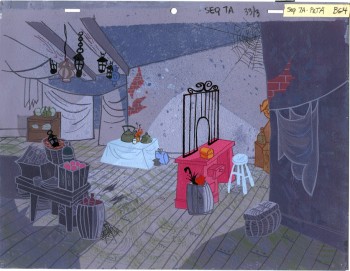 There are dozens of photos, including extremely rare shots from the song recording session. A great deal of art from the film illustrating all phases of production has been scanned or acquired for use in the book. There are over 230 pieces of art, including rare early concept sketches and at least two dozen background paintings, all of which were thought to be lost.
There are dozens of photos, including extremely rare shots from the song recording session. A great deal of art from the film illustrating all phases of production has been scanned or acquired for use in the book. There are over 230 pieces of art, including rare early concept sketches and at least two dozen background paintings, all of which were thought to be lost.
The story of the making of Mr. Magoo’s Christmas Carol will reveal
previously unknown information regarding the production as well as
dispel a number of myths currently circulating on the internet.
A labor of love, this book will be self-published by Darrell Van Citters who is a director at Renegade Animation.
According to Cartoon Brew, it will be on sale at the San Diego Comic Con, July 23-26. I won’t be there, but I’m looking forward to this book.
- I can remember waiting with great anticipation for that very first airing of this show. I had seen 1001 Arabian Nights with Mr. Magoo two years earlier and loved it. As a kid, I was more than a bit partial to high design in animation. I haven’t lost that thrill of beautifully designed artwork for the medium.
TV Guide had printed a fraction of a treasure that I studied endlessly; it was a bit of the storyboard for this film. I saved it to this day. (It’s in storage or I’d post some of it.)
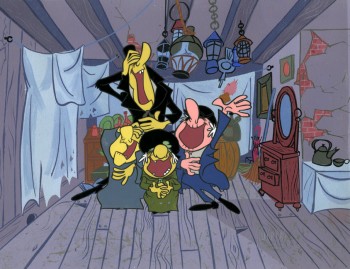 The show won me over, and I’ve seen it dozens of times since. It’s still about my favorite holiday tv special. What’s not to like? Jule Styne and Robert Merrill were at the top of their game and had just come off the high of writing Funny Girl for Broadway. They brought equally fine, melodic songs to this show. Walter Scharf who orchestrated it, was a strong film musician. he’d worked on everything from Danny Kaye’s Hans Christian Andersen to Jerry Lewis’ Nutty Professor. He had scored or orchestrated many other films, even working on Mr. Bug Goes To Town as an orchestrator.
The show won me over, and I’ve seen it dozens of times since. It’s still about my favorite holiday tv special. What’s not to like? Jule Styne and Robert Merrill were at the top of their game and had just come off the high of writing Funny Girl for Broadway. They brought equally fine, melodic songs to this show. Walter Scharf who orchestrated it, was a strong film musician. he’d worked on everything from Danny Kaye’s Hans Christian Andersen to Jerry Lewis’ Nutty Professor. He had scored or orchestrated many other films, even working on Mr. Bug Goes To Town as an orchestrator.
The animation was limited, but it was superb. Abe Levitow was at his height as a director and animator, and he
directed with snap and intelligence. Duane Crowther and Gerard Baldwin offered superb animation. To this day, I think the tight script stands as a lesson in how to adapt a story. It has to be one of the two best adaptations of the Dickens classic.
It’s a staple that should be aired every christmas.
For more on Abe Levitow and this film check out his site: here.
Art Art &Daily post 20 Mar 2009 08:17 am
$9.99/Patti/Natasha
- Tatia Rosenthal‘s clay animated feature, $9.99, will make its NY debut as part of the Lincoln Center Festival: New Directors/New Films. Her film will be screened twice:
Sunday March 29th at 70pm at MOMA and
Wednesday April 1st at 9pm at the Walter Reade Theater in Lincoln Center.
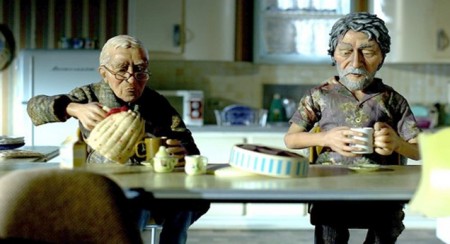
Tickets can be bought on line or at the door for $10.
.
.
A show of photographs by artist, Patti Smith opened last night at:
the Robert Miller Gallery
524 West 26th Street
(212) 366 4774
The show will run from March 19 through April 18th.
Like everything else from this extraordinary artist, the work is beautiful, poetic and well worth your interest. Go.
.
- Speaking of wrenching, following the sad events leading to the death of Natasha Richardson was so sad.
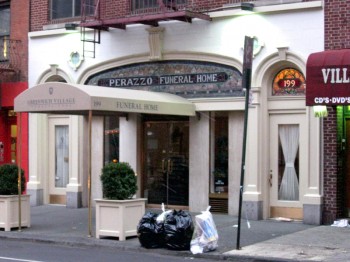 Months ago Heidi and I happened to be sitting just behind her and Liam Neeson at a performance of Les Liaisons Dangereuses at the Roundabout Theater. They made a couple of small quiet comments during the show. She rested her head on his shoulders several times. I’m sure they felt unwatched (as much as any celebrity in public can be) and were so obviously in love with each other.
Months ago Heidi and I happened to be sitting just behind her and Liam Neeson at a performance of Les Liaisons Dangereuses at the Roundabout Theater. They made a couple of small quiet comments during the show. She rested her head on his shoulders several times. I’m sure they felt unwatched (as much as any celebrity in public can be) and were so obviously in love with each other.
The funeral home used for the wake is a block away from____They left at intermission,
my studio. It’s listed as “Greenwich Village Funeral Home,____though they undoubtedly
but they obviously use another name over their front door.___went backstage to see
___________________________________________________Ms. Linney. Throughout this entire week’s events, I was only able to think of the two of them as they were at that performance. She with head on his shoulder. Alive and human.
Commentary 19 Mar 2009 08:34 am
Gates of Heaven
- Back in 1980, I was an ardent follower of the NY Film Festival. There were great films entering the market. It was tough to get into screenings, but I’d figured out a way and was able to attend whatever I wanted. One of the films I saw that year was a Gates of Heaven by Errol Morris. Morris had been working with Werner Herzog on Strozek. Herzog was my god at the time, so I was particularly interested in seeing Morris’s work and went to see the film and hear a Q&A with him afterwards.
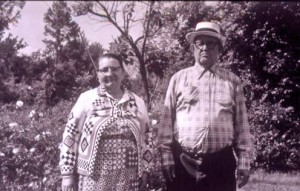 The slow and purposefully timed “documentary” was about a pet cemetary that moved its site from LA to SF and the people that were involved with the pets buried there. During the film there were many groans from the crowd. At least ½ of the audience left mid-screening. It was an odd film, very different in approach from Herzog. As a matter of fact it was very different from any documentary I’d seen before. I loved it.
The slow and purposefully timed “documentary” was about a pet cemetary that moved its site from LA to SF and the people that were involved with the pets buried there. During the film there were many groans from the crowd. At least ½ of the audience left mid-screening. It was an odd film, very different in approach from Herzog. As a matter of fact it was very different from any documentary I’d seen before. I loved it.
The first question put to Morris during the post-film Q&A came from a woman up front who said, “I think your film would have been better if had been cut in half.” Morris’s instant response was, “I think you’d be better if YOU were cut in half!” That’s when the festival director and moderator of the program, Richard Roud, put his head on the table in front of him and realized it was going to be one of those sessions.
While watching the film, I was entranced. About 3/4 of the way through it, I started thinking about my medium – animation. Here, in front of me was an “Anti-New Wave” (my label) film.
However, my medium hadn’t gone through anything comparable to the “New Wave” yet – never mind be ready for an “Anti-New Wave”! Oh, despair.
Where was there to go with this? Animation had gone from 19th Century realism to 20th Century art styling, yet it hadn’t grown up in the bigger picture – content.
In the post screening discussion with my companion, I expressed my thoughts and depression. I needed only one reminder to pull me out of it. Tale of Tales.
Something had happened with that film (on the back of the Hubleys and some of the other modern animation filmmakers) to literally push the medium beyond itself.
To this day, I’m not sure anything has gone beyond Norstein to the next step in developing animation to a bigger level. As a matter of fact, I think things have retrogressed. Sure the current films would pass Robert McKee’s story structure tests, but they aren’t rich. CG movement is smoother, but the films aren’t bigger. In a way, we’re back to the Bobby Bumps era … happy about the movement and ignorant of the complexity of storytelling.
I sound so pessimistic when I reread this, but I that’s not how I feel. I think I’m enormously optimistic. I hope and expect someone to surprise me with something that will turn a new corne and thrill me. Animation hasn’t done that for quite some time, but I know it will.
There’ve been lots of exciting pieces that almost make the mark, and I could start naming a long list of films that were enormously encouraging. Schizein and Madame Tutli-Putli were the most recent to excite me. But I’m looking for something that’s at least as good as anything done in live action. (Even that’s not a high threshold, these days.) I’m looking for something that will change the way I think. It’s going to show up soon – maybe, I’ll be the one to do it. In the meantime, I’ll keep looking.
Books &Disney &Peet 18 Mar 2009 08:06 am
So Dear #5
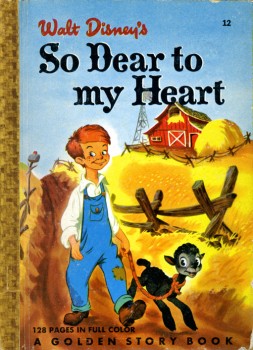 - Here’s the conclusion to the Little Golden StoryBook, So Dear To My Heart. The book is an adaptation, of course, of the movie by Helen Palmer with illustrations by Bill Peet.
- Here’s the conclusion to the Little Golden StoryBook, So Dear To My Heart. The book is an adaptation, of course, of the movie by Helen Palmer with illustrations by Bill Peet.
At 128 pages, the book is quite long and chock full of gems by Bill Peet. It’s one of his first publications and shows a lot of the hallmark look he’ll have once he bagan writing and illustrating his own books, although they’re considerably shorter (averaging about 30 pages.) These ink and watercolor illustrations are all spot drawings and fill usually about a third of the page. The colors are limited with an inexpensive printing process used on inexpensive paper. At 5″ x 7″, the book is also a bit smaller than the usual Golden Book.
Here are the last two chapters:
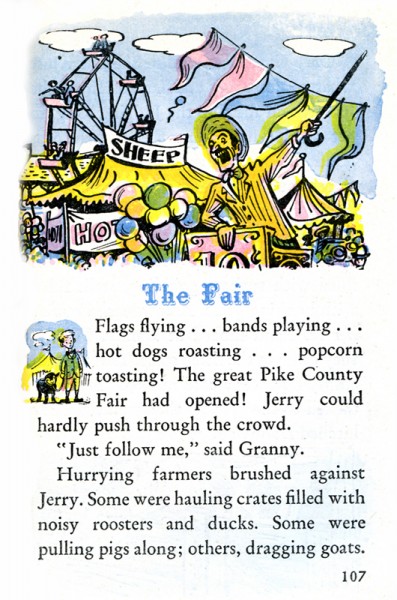
(Click any image to enlarge.)
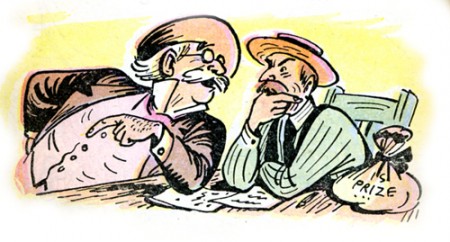
This drawing, alone, is worth the entire book. It’s beautiful and shows
Peet’s brilliance at capturing characters in a specific moment of time.
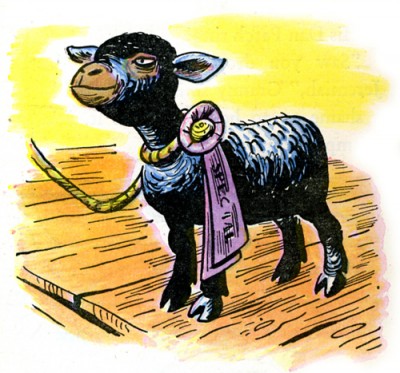
Most illustrators would probably have ended the book on this image of
the grand prize winner – such a temptation, the climax of the book.
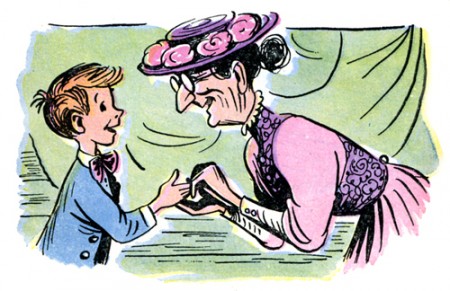
Peet is character driven and knows that the book is about the boy.
The last image has to be a shot (did I say shot? this isn’t a film. I meant
to say) picture of the real hero of the story . . . the boy.
Daily post 17 Mar 2009 08:19 am
St. Pat, the Book of Kells & Ghibli

(Click any image to enlarge.)
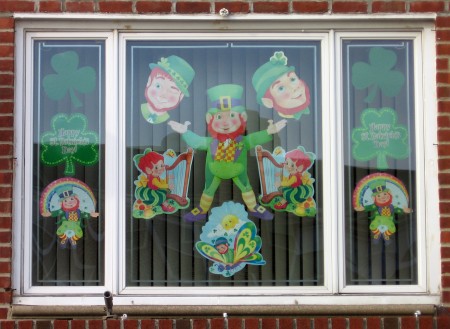
There are those who are Irish, and those who
decorate their windows as if they were Irish.

A day to spend in the New York Tavern.
Thanks for the photos from Queens by Steve Fisher.
_________________
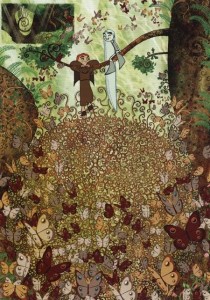 -Brendan and the Secret of the Kells seems to be the animated feature to watch in 2009. Over the weekend the film was the big winner at the Berlinale at this year’s Cartoon Movie in Lyon, winning best European director and best producer.
-Brendan and the Secret of the Kells seems to be the animated feature to watch in 2009. Over the weekend the film was the big winner at the Berlinale at this year’s Cartoon Movie in Lyon, winning best European director and best producer.
More than six hundred participants voted for the Cartoon Movie Tributes which recognise companies or personalities exercising a positive and dynamic influence on the European animation feature film industry. Irish animator Tomm Moore was named best European director of the year for his feature debut which had had its world premiere in the Berlinale’s Generation sidebar last month.
This film was directed in Ireland by Tomm Moore at his studio (partnered with Paul Young) the Cartoon Salon. His codirector was Nora Twommey. The film was produced in cooperation with the French company, Les Armateurs, the company that produced the wonderful The Triplettes of Belleville. The €6 million budget was raised from a number of European countries.
You can see a one-minute trailer on line here.
You can see three good clips here.
(Thanks to Koen De Koninck for the lead.)
Here are some reviews:
Variety
______Space is distorted so that everything looks deliberately flattened, yet there’s a very high level of craft deployed throughout to build up patterns within patterns. This may be the perfect film for children whose parents are art historians specializing in pre-Renaissance periods.
______That ‘s not to say others won’t enjoy it, but finding an aud is going to be a challenge for marketing departments. Despite the many participants from across Europe listed in the credits, the pic’s most fruitful territory is likely to be Ireland, and even there, competition with Hollywood fare will still be tough.
The Irish Times
______The story does have a neat arc and the voice-work is first rate, but the thinly drawn characters are sometimes upstaged by the bold images and by the fine, insistent music from KÃla and Bruno Coulais. Moreover, the desire to pack in so much research seems to have occasionally overpowered the need to create a clean narrative line.
______These are quibbles. The Secret of Kells remains a surprising piece of work that should appeal to smart children and open-minded adults. Chemically befuddled students may enjoy it even more.
Screen Daily News
______Director Tomm Moore and his team really excel themselves in these forest sequences, where Irish monasticism meets Busby Berkeley. At times, motifs from megalithic passage graves and Celtic jewellery float in the background like micro-organisms under a microscope, or fall in the form of snowflakes. Perspective is flattened out, and Brendan and Aisling are framed inside branches, just as Biblical characters were framed inside the opening letters of illuminated manuscript pages.
- Now on to Japan
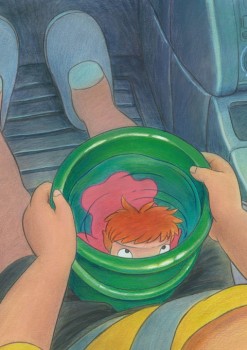 - Studio Ghibli has teamed with Toyota to start a new animation training system for young people. Beginning April, 20 new employees will be sent to Aichi Prefecture in western Japan for a two-year course to learn animation techniques while being exposed to robotics and other Toyota technologies. Miyazaki and other veteran Ghibli animators will give lectures to the group.
- Studio Ghibli has teamed with Toyota to start a new animation training system for young people. Beginning April, 20 new employees will be sent to Aichi Prefecture in western Japan for a two-year course to learn animation techniques while being exposed to robotics and other Toyota technologies. Miyazaki and other veteran Ghibli animators will give lectures to the group.
The intent is to give students an appreciation for the traditional handcrafting skills still found at Toyota. This training, Ghibli producer and former president, Toshio Suzuki believes, will make them a better fit with the Studio Ghibli aesthetic.
It’s an unusal path, but the goal seems to be for the students to learn the hand-drawn art form in conjunction with the latest cg technology. I don’t think there’s anything comparable in the US.
Animation &Animation Artifacts &Tissa David &walk cycle 16 Mar 2009 07:43 am
More Mt. Dew
- Last week I posted some animation drawings done by Grim Natwick which he animated in a spot for Mountain Dew. The drawings I posted were actually the assistant’s drawings done by Tissa David. The spot was produced by Robert Lawrence Productions.
This is another run cycle from that same film. Again, all of the drawings, here, are Tissa’s clean-ups.
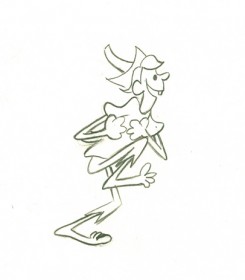 1
1 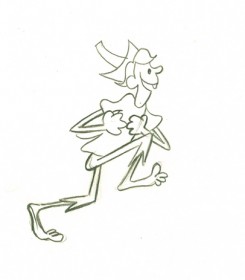 2
2(Click any image to enlarge to actual animation sized drawing.)
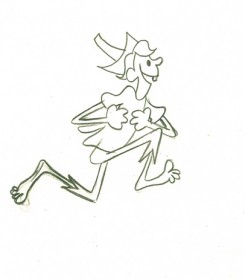 3
3 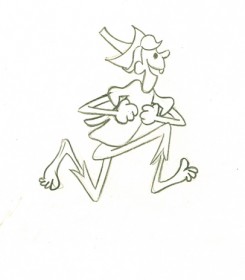 4
4
You’ll note that the character leaves the ground for 1/3 of the spot.
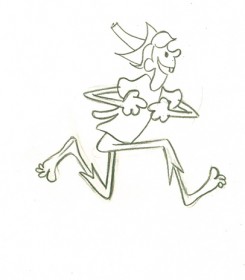 5
5 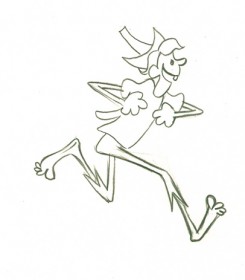 6
6
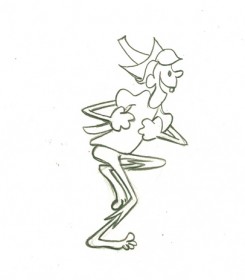 9
9 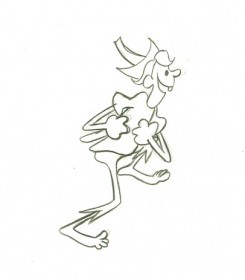 10
10
He actually comes down in the crossing position rather than the
classically designed walk where the head moves up.
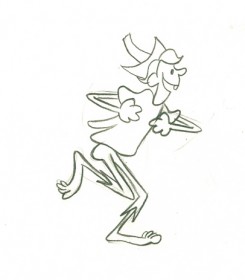 17
17 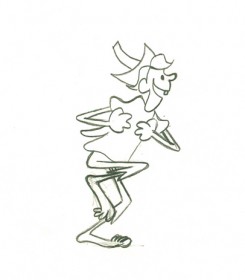 18
18
Tissa’s tnedency is to have the crossing position the lowest in the cycle.
The character bears the weight of his walk with feet solidly on ground.
On ones at 24FPS
Click left side of black bar to play.
Right side to watch single frame.
Commentary &Photos 15 Mar 2009 07:58 am
Peevish
- Walking around New York one starts to see a lot of small annoying things that get catelogued somewhere in the recesses of one’s brain. Eventually, I think those annoyances have to be released. Let me tell you, I have a lot of them. What’s a blog for if not for that release, so here I am sharing. Sorry about that.

This uninteresting little bit of Broadway meeting Fifth Avenue is getting me
more and more annoyed as time goes on.
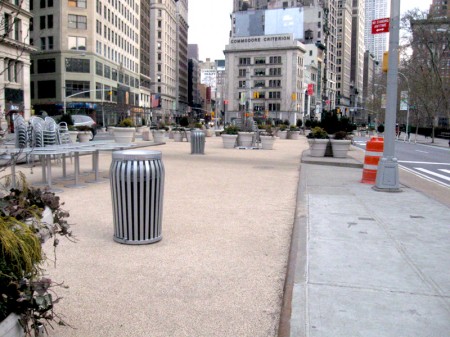
Last year, Mayor Bloomberg’s administration decided that several areas of
street traffic should be closed and turned into a sit-down area with tables.
IN THE MIDDLE OF FOUR LANES OF TRAFFIC!
The two middle lanes were turned into a rest area where people
could sit their weary bones and watch traffic swirl about them.
I shot these pictures early morning. Tables and chairs had to be set up,
and someone does this daily. A guy was in the background sweeping
the area at 6:30am Saturday when I took the pictures.
You can’t see it vivdly in my photos, so I’ve done a quick aerial map.
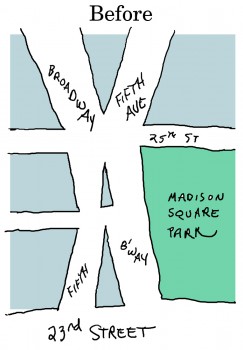
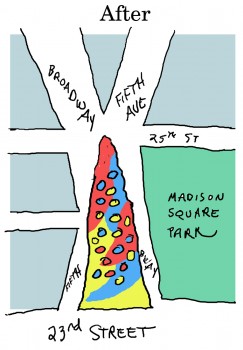
Left: You can see that three lanes of traffic on Broadway crossed and
ran into three lanes of traffic from Fifth Avenue.
Right: After the “Fun and Games Area” has been added to the center of this
traffic center, cars are reduced to four lanes total – including lots of busses.
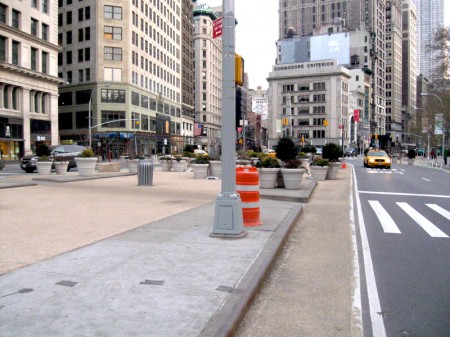
Now you can sit watching the swirling traffick, swallowing plenty of exhaust fumes
while you look across to Madison Square Park a distant 20 feet away.
What sense makes this!?!

Rocks like these line both sides of the triangle so that any careening car
won’t crash through the seated folk resting.

The lovely foliage adds to the experience.
A similar area was done in Times Square!
This summer, the cars will be turned away from these areas, and the streets
will become a pedestrian mall. No cars on 42nd Street and Broadway!
Try walking with the other thousands of people enjoying a delightful
hot summer evening in the middle of the street – Times Square.
Try getting a cab after the theater.
It’s the mall-ization of New York. Every eve’s going to be New Years Eve!
Every day Christmas.
____________________


Left: For years, we put up with this mile-high crane on 23rd Street –
always waiting for it to come crashing down on us.
Right: The end result is this hideously unattractive building. I tried to make it look interesting by shooting it from the park, surrounded by trees. It didn’t work.
____________________
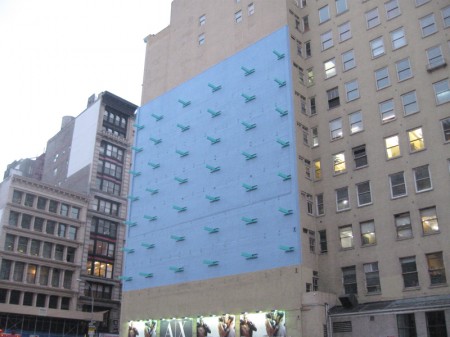
Finally, for today, could someone tell me what the hell this is!
In an area surrounded by enormous posters painted or draped onto
the sides of buildings on Houston Street, this one has this.


Are these clips or hangars or what?
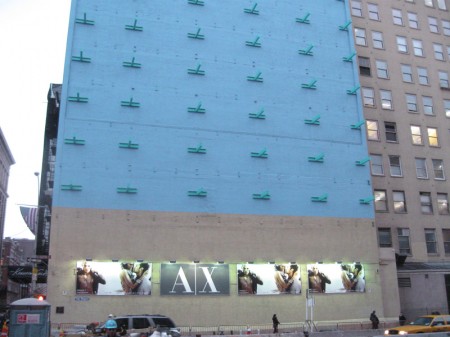
Is it an artwork? An ad? Something different from Banksy?
A year it’s been there, and I don’t know what or why.
________________________________
On the positive side. There’s New York’s newspapers and the on-line versions.
Today’s NYTimes includes an informative article about William Kentridge and includes one of his animated films, Tide Table. It’s a must-view for those interested in animation as an art form.
Better yet, if you live in San Francisco, go to the San Franciso Museum of Art where a retrospective of Mr. Kentridge’s work opens next Saturday.
Articles on Animation &Disney 14 Mar 2009 08:12 am
After Walt
- Didier Ghez on his site Disney History recently posted an article about life at the Disney Studio after Walt’s death in 1966. There were quite a few such articles during this period, and we were made to hope something would happen to generate life into the animation division of a company that was turning out bad films.
Time Magazine had the following article in their Aug. 16, 1979 issue:
CORPORATIONS
Running Disney Walt’s Way
When lung cancer killed Walt Elias Disney a decade ago, there were fears that the world of Disney would lose some of its wonder—and its profits. But before his own death in 1971, Roy Disney, who succeeded his younger brother, and a cadre of post-Walt executives had turned Walt Disney Productions into a thriving empire of fantasy. Today the company is bigger and richer than ever. Profits flow in from Disney’s two successful theme parks, Disneyland in California and the magic kingdom at Walt Disney World in Florida, from film rentals and television, from re-releases of such longtime favorites as Bambi, Pi-nocchio and Fantasia, and from sales of record albums, Mickey Mouse wrist-watches and everything else bearing the Disney stamp.
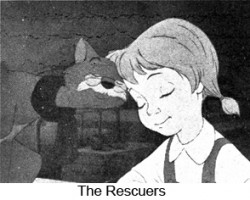 Last year the various forms of escapism earned Disney nearly $62 million on sales of $520 million—four times the total in 1966 when Walt died. For the first nine months of its current fiscal year, Disney was flying higher than Dumbo the elephant. Corporate profits were up 30%, and sales rose 16%. More than 6 million people flocked to Disneyland (which turned 21 in July), another 9 million to Disney World. The fifth re-release of the animated Snow White and the Seven Dwarfs, which came out in 1937, will gross an estimated $10 million in the U.S. alone by the end of this year.
Last year the various forms of escapism earned Disney nearly $62 million on sales of $520 million—four times the total in 1966 when Walt died. For the first nine months of its current fiscal year, Disney was flying higher than Dumbo the elephant. Corporate profits were up 30%, and sales rose 16%. More than 6 million people flocked to Disneyland (which turned 21 in July), another 9 million to Disney World. The fifth re-release of the animated Snow White and the Seven Dwarfs, which came out in 1937, will gross an estimated $10 million in the U.S. alone by the end of this year.
Analysts’ View. No one questions that Disney has come a long way since the studio gambled $1.5 million on Snow White. But Wall Street analysts insist that the company should be doing even better and are hypersensitive to any developments that could remotely be considered adverse. Last month, for example, Disney stock fell several points (to around $50, or more than 20 times earnings) because third-quarter earnings, though a record $19 million, were not up to Wall Street’s expectations. Says a Disney vice president: “That’s a source of irritation around here. They seem to run in a pack on the Street.”
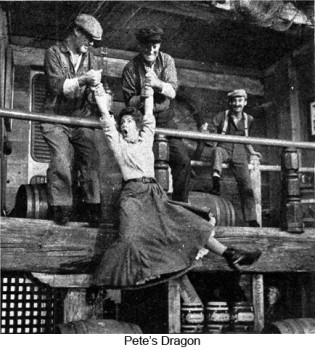 The founder’s ideas still run the show: almost everything Disney is now into was conceived of by Walt. “That’s the way Walt would want it” is a refrain heard frequently in the stucco Disney headquarters in Burbank, Calif. The executive most responsible for sticking to Walt’s winning formulas is E. Car-don Walker, 60, who joined Walt as a camera operator in the 1930s and has been Disney president since 1971. A tall, husky man whose use of profanity is limited to an occasional G-rated “damn,” Card Walker occupies an unpretentious office on the Disney lot not far from Dopey Drive and Mickey Avenue. His only concessions to the Hollywood movie mogul image are tinted glasses and a sleek gray Porsche (license plate: CAR WIN).
The founder’s ideas still run the show: almost everything Disney is now into was conceived of by Walt. “That’s the way Walt would want it” is a refrain heard frequently in the stucco Disney headquarters in Burbank, Calif. The executive most responsible for sticking to Walt’s winning formulas is E. Car-don Walker, 60, who joined Walt as a camera operator in the 1930s and has been Disney president since 1971. A tall, husky man whose use of profanity is limited to an occasional G-rated “damn,” Card Walker occupies an unpretentious office on the Disney lot not far from Dopey Drive and Mickey Avenue. His only concessions to the Hollywood movie mogul image are tinted glasses and a sleek gray Porsche (license plate: CAR WIN).
Walker believes that “the biggest challenge we face is still to make top-quality films,” and film critics tend to agree. Though slick and successful, the recent crop of Disney animated and live-action films (Gus, Treasure of Mate-cumbe, Robin Hood) shows little of Walt’s skill at tugging an audience over pop-emotional peaks and valleys. Nor do the forthcoming The Rescuers and Pete’s Dragon. Indeed, not since Mary Poppins in 1964 has Disney produced a genuinely smashing, supercalifragilisti-cexpialidocious hit.
This fact troubles Walt’s corporate heirs. Says Walker: “I don’t know exactly what it is. We don’t cut costs. Based on the quality of people involved in the film making, I would just have to say that we do our best.” Others blame excessive reverence for the traditional Disney method of moviemaking: batteries of cartoonists working under a rigid discipline on a single project for as long as three years. Says one young artist-animator who worked briefly for Disney: “The work is too confining. There’s not enough room to use your creative talents. It’s sterile.”
More and more, Disney is setting its animators to work on gutsier movies that seize audiences instead of rocking them to sleep. One feature in the storyboard stage, The Hero from Otherwhere, is about two schoolboys who find themselves on a strange planet whose black leader persuades them to help destroy a wolf that has been ravaging the land. Another, Spacecraft One, about a mile-long spaceship in its search for life on other planets, is Disney’s most elaborate sci-fi undertaking since 20,000 Leagues Under the Sea. The Black Cauldron, still in the treatment-writing stages, is about a pig keeper’s struggle with a villain whose shtick is regenerating an army of warriors from dead bodies—a long way from Poppins. Sex and excessive violence still are taboo on the Disney lot, but Walker foresees increased sophistication as younger animators reflect contemporary themes.
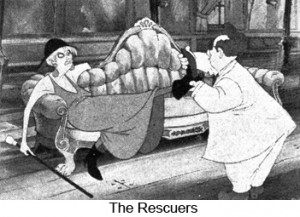 Non-film projects, however, account for three-fourths of Disney revenues and therefore generate the greatest excitement in the Disney organization. With Disneyland and Walt Disney World booming, the company is now moving on the biggest of Walt’s ideas: EPCOT, or Experimental Prototype Community of Tomorrow. To be built by the early 1980s in Florida as an expansion of Disney World, EPCOT will be a living laboratory of applied technology in transportation, housing, communications and waste disposal. Near it will rise the World Showcase, a permanent World’s Fair. Still another theme park. Oriental Disneyland, now planned to open late in 1979, will border Tokyo Bay in Japan; the Disney people expect it to draw 10 million visitors annually at the tourist hub of Asia. Estimated cost: about $175 million—most to be borne by the Japanese.
Non-film projects, however, account for three-fourths of Disney revenues and therefore generate the greatest excitement in the Disney organization. With Disneyland and Walt Disney World booming, the company is now moving on the biggest of Walt’s ideas: EPCOT, or Experimental Prototype Community of Tomorrow. To be built by the early 1980s in Florida as an expansion of Disney World, EPCOT will be a living laboratory of applied technology in transportation, housing, communications and waste disposal. Near it will rise the World Showcase, a permanent World’s Fair. Still another theme park. Oriental Disneyland, now planned to open late in 1979, will border Tokyo Bay in Japan; the Disney people expect it to draw 10 million visitors annually at the tourist hub of Asia. Estimated cost: about $175 million—most to be borne by the Japanese.
Double Duty. Whatever its problems, Disney has perfected one talent that other Hollywood fantasy factories envy: piggybacking. The familiar cartoon characters boost attendance at the theme parks, and the parks increase attendance at the movies. Though no one at Disney claims to be Walt’s equal in artistry or dreaming, Card Walker has made Disney’s characters do double duty as stars and as barkers to all the world. As a merchandising idea, it has proved to be almost as successful an inspiration as the original Mickey Mouse.
Chuck Jones &Daily post 13 Mar 2009 08:01 am
Jones’ Memories and Manga
- Chuck Jones: Memories of Chldhood is a film by Peggy Stern. John Canemaker also served as producer and director of animation.
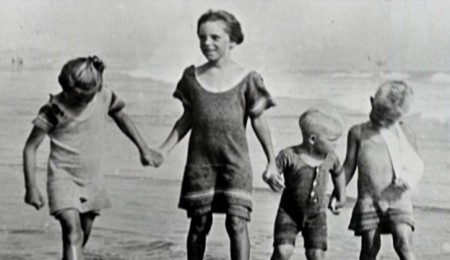
In 1997, John brought Peggy Stern and Chuck Jones together for a series of interviews that became the basis of this film. Jones often sketched his boyhood self as he related his memories. These sketches later inspired the documentary’s animated sequences, which Canemaker directed.
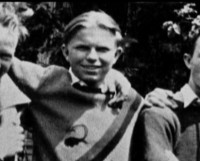 Just prior to his death Jones saw a rough version of the film and was delighted. His family sunsequently provided Ms. stern with additional archival material. The end result is an intimate film about the early years of Chuck Jones’ life.
Just prior to his death Jones saw a rough version of the film and was delighted. His family sunsequently provided Ms. stern with additional archival material. The end result is an intimate film about the early years of Chuck Jones’ life.
This film is going to air on Turner Classic Movies Tuesday, March 24th at 8 p.m, and it will be followed by three classic Jones shorts: Duck Amuck, One Froggy Evening and What’s Opera Doc.
- An exhibit celebrating Manga and Anime is opening tomorrow, March 14th, at the Japan Society in New York. has
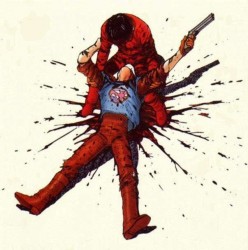 The films that will be shown include:
The films that will be shown include:
___ Katsuhiro Otomo’s classic, Akira (1988)
___ Masaaki Yuasa’s Mind Game (2004)
___ Satoshi Kon’s, Paprika (2006)
___ Patlabor 2: The Movie, by Mamoru Oshii _____ (1993)
___ The Place Promised in Our Early Days _____ (2004), by Makoto Shinkai
and
___ Super Dimension Fortress Macross:
_____ Episode 9, 17, 18, and 27 (1982-83),
_____ designed by Ichiro Itano.
Screenings will begin Saturday, March 14 and will continue until June 14, 2009.
The exact Anime screening schedule in the auditorium is here
A listing of Manga on display is here.
The NYTimes has a review of this show in today’s paper.
Animation &Animation Artifacts 12 Mar 2009 07:58 am
Taras & Fritz
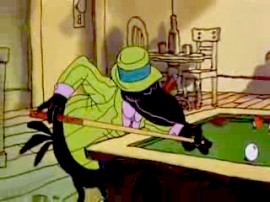 - Reading a short piece about Ralph Bakshi on David Levy’s Animondays blog, brought me back to my collection of drawings. Here are some drawings from Fritz the Cat, the first scene of the pool sequence.
- Reading a short piece about Ralph Bakshi on David Levy’s Animondays blog, brought me back to my collection of drawings. Here are some drawings from Fritz the Cat, the first scene of the pool sequence.
The drawings are by New York staple, Marty Taras. He, Johnny Gentilella and Nick Tafuri all had similar drawing styles. The clean rough. An inker could (and did at Hubley’s) work directly from their drawing without a cleanup by and an Assistant. These drawings were assisted by Jim Logan, who gave the drawings to me back in 1976.
(Johnny was an amazingly sweet guy, who spent a lot of time teaching me much in those early days. Marty was someone whose defenses always seemed to be up. Perhaps this is the reason he was the brunt of som many gags back at Terrytoons. Nick, when I knew him, was grumpy. He seemed not very talkative – just wanted to hand in the job and get outta there. But he did a couple of the best takes I’ve ever seen in the animation he handed in.)
Marty’s style was to work so light that it’s a struggle to see the red lines. For these scans, I had to darken the artwork so that the paper ends up with a bit more yellow than it has in reality.
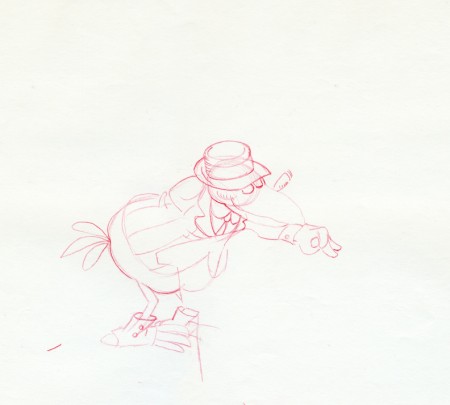
The crow chats with Fritz.
His arm and pool cue are on another level.
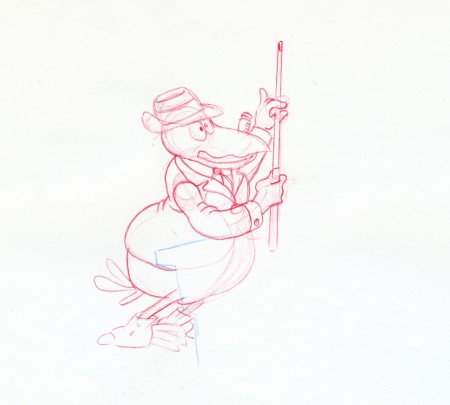
(Click drawings for enlarged versions of the entire animation sheet.)
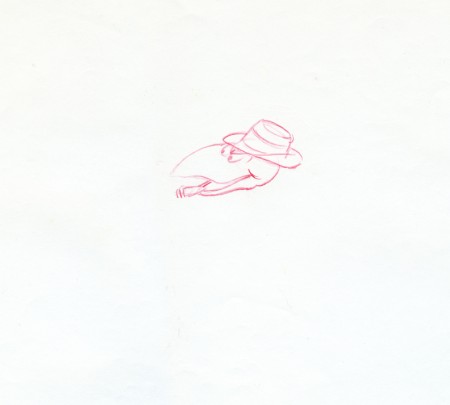
Crow’s head moves to a separate level as he chats with Fritz.
